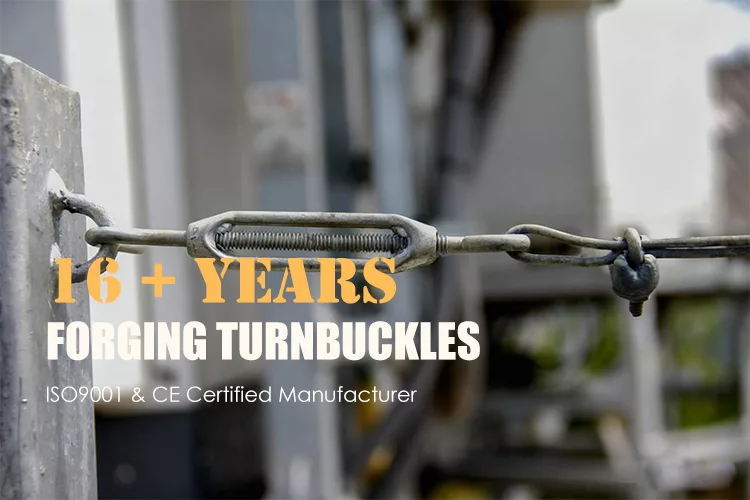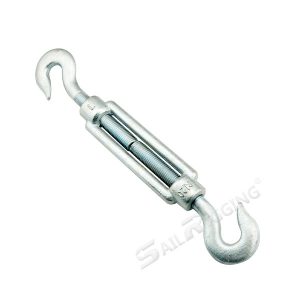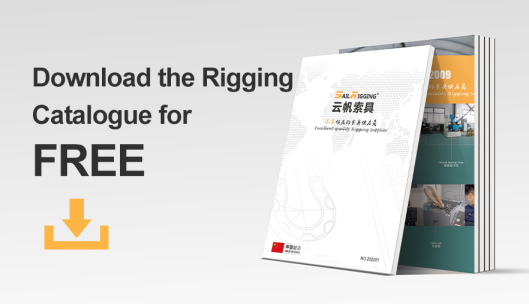The Comprehensive Guide to Turnbuckle Hardware: Type, End Fitting, and Size
Turnbuckles are a commonly used rigging hardware for adjusting wire rope tension in industries such as oil and gas, construction, shipping, mining, and fishing. Turnbuckles come in a wide variety of types, from open to closed, and from American Standard to Japanese and German Standards. Materials also vary widely, from low-carbon steel and high-carbon steel to stainless steel. End fittings can be freely combined and matched according to needs. Below, we share comprehensive information about turnbuckles, including what a turnbuckle is, types of turnbuckles, turnbuckle fittings, and how to measure dimensions.
Table of Contents
What Is A Turnbuckle?
A turnbuckle, also known as a rigging screw, tensioner, tensioning bolt, or adjustable bolt, is a device used to increase or decrease the tension or length of ropes, cables, tie rods, and other tensioning systems. A turnbuckle has a left-hand thread on one end and a right-hand thread on the other, so rotating the turnbuckle body adjusts its open/closed state, thereby tightening or loosening the tension of the wire rope or cable. Clockwise rotation increases tension, while counter-clockwise rotation decreases it. This reverse thread design makes turnbuckles a simple yet essential tool for lifting heavy objects, securing wire rope assemblies (such as marine rigging), and fixing building components (such as cable barriers).
Turnbuckle Type
US Type Drop Forged Turnbuckle
Made of high-strength carbon steel 45# and hot-dip galvanized, conforms to ASTM F1145, making it ideal for construction, marine, and industrial applications. According to shape, they are divided into: hook type turnbuckle (CC) (Hook & Hook), hook eye type turnbuckle (CO) (Hook & Eye), eye and eye type turnbuckle (OO) (Eye & Eye), eye jaw type turnbuckle (OU) (Eye & Jaw), and jaw type (UU) (Jaw & Jaw). The fracture coefficient is 1:5, no deformation coefficient. Locknuts can be added to the threaded sections at both ends of the turnbuckle.
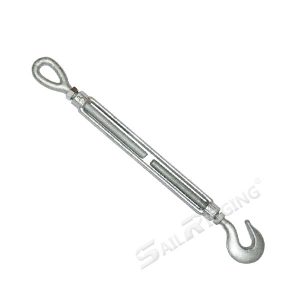
JIS Type Frame Turnbuckle
Made of high-strength carbon steel (C1045), comforms to JIS A 5541-2008 standard. It is widely popular in the Japanese domestic market.The surface is electro-galvanized, providing a secure connection for ropes, cables, and other rigging components. They are widely used in construction, shipping, and industrial fields. There’re 2 type of JIS type turnbuckle, hook eye type turnbuckle, hook hook type turnbuckle, eye and eye turnbuckle, stub ending turnbuckle.
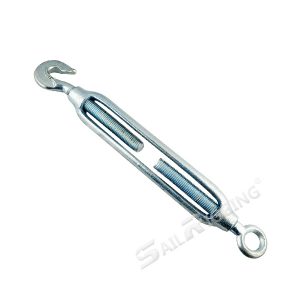
DIN1480 Turnbuckle
DIN1480 claw-type tensioners are manufactured according to the DIN1480 standard, using high-quality forged steel to ensure superior strength and durable performance. The electro-galvanized finish provides excellent corrosion resistance, making them widely used in lifting, tensioning, and securing operations. There’re 6 type of DIN1480 turnbuckles, hook and hook turnbuckle, hook eye turnbuckle, eye and eye turnbuckle, eye jaw turnbuckle, jaw and jaw turnbuckle.
DIN1478 Turnbuckle
Manufactured according to the DIN1478 standard, these turnbuckles feature a closed or sealed body structure. They typically consist of two end fittings, a threaded rod, and a tubular body enclosing the threaded rod. The end fittings are typically eye bolts, eye nuts, or hooks, facilitating the connection of ropes, cables, or other tensioning elements. Compared to open turnbuckles, closed turnbuckles provide additional protection for the internal threads and mechanism, acting as a shield.
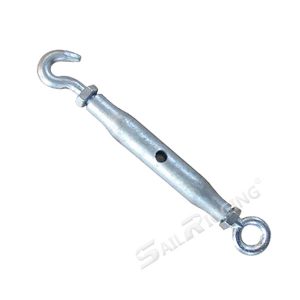
Commercial Type Turnbuckle
Commercial turnbuckle hooks are durable and cost-effective rigging solutions designed for general applications. Made of malleable cast iron and electro-galvanized for enhanced corrosion resistance, they are suitable for outdoor, industrial, and marine environments. There’re hook and eye turnbuckle in common, hook and hook turnbuckle, eye and eye turnbuckle.

Turnbuckle End
Given the need for turnbuckles in numerous industries to ensure wire rope tension and safe load-bearing capacity, various types of turnbuckle end pieces exist. This article introduces four of the most common turnbuckle end pieces and their application examples.
Hook End Fitting
Used for temporary connections, hook-end connectors are much easier to install and connect or disconnect from other rigging components compared to jaw turnbuckles and ring-to-ring turnbuckles. However, due to the lack of a safety lock, hook-end connectors are far less practical than jaw turnbuckles and ring-to-ring turnbuckles; the safety lock may accidentally detach from the connected rigging component, causing the hook to fall off.
Jaw End Fitting
Composed of jaw plates, bolts, and nuts, but depending on size, some jaw-end tensioners only come with cotter pins and ferrules. They allow the wire rope sling to be directly connected to the jaw end and secured to the eye bolts and lugs via ferrules; these components cannot be opened.
Eye End Fitting
Only suitable for linear traction or linear applications, not for lifting. They have no moving or opening parts and are designed to pass through a shackle or quick-connect ring at each eye end before connecting the wire rope sling or other approved rigging assembly.
Stub End Fitting
Stub end fitting are a good choice for permanent, secure connections to anchor points. They can be welded directly to the connecting component to push objects away or apply tension.
Depending on the application and whether the solution is permanent or temporary, different combinations of tensioning screw ends are selected to adjust the wire rope tension.
How to Measure Turnbuckle Size
Accurate measurement of turnbull seals is necessary when selecting them. Below, we introduce the key dimensions and how to measure them. Steps to measure the size of a turnbuckle:
- Rotate the center frame (fastening device) clockwise until the two threaded rods pass through the frame and their ends fully contact, ensuring the turnbuckle is fully closed.
- Measure the diameter of the threaded rods using calipers. Place the calipers near the first thread on the eyelet, hook, or chuck, ensuring the calipers do not touch the thread or are too far away to affect measurement accuracy. Record this measurement as “A”.
- Measure the internal length of the fastening device using a ruler. The fastening device is tightened or loosened by rotation. The internal frame is rectangular, and the threaded rods can be seen through the frame. Measure the distance between the connecting ends of the internal frame and mark it as “BB”.
- Find the entry in the turnbuckle load table that matches the measured values A (thread diameter) and BB (fastening length). This will provide you with the turnbuckle size and its load capacity. Each turnbuckle size corresponds to a unique load capacity, and the combinations of thread diameter and fastening length in the load capacity table are different; there are no identical combinations.
Tips For Measure Total Length:
- Ensure the turnbuckle is fully extended to its maximum length.
- Determine the total length by measuring the distance between the centers of the end fittings.
Tips For Measure Thread Diameter:
- Use calipers or a measuring tape to accurately measure the diameter of the threaded portion on the circumference of the turnbuckle body.
- Be sure to measure at the widest point of the thread for accurate results.
Tips For Determine End Fitting Dimensions:
- Determine the inner diameter of the hook, ring, or claw on the turnbuckle end fitting.
- To determine the hook size, measure the gap or spacing between the inner edges of each hook component.
- To determine the ring size, measure the span between the innermost edges of the ring.
- To determine the claw size, measure the spacing between the inner edges of the claws.
Understanding the types, models, materials, and sizes of turnbuckle threads is crucial for selecting the appropriate turnbuckle thread. If you would like to learn more about practical knowledge regarding turnbuckles, please contact us at manager@qdsailrigging.com. We are happy to share more useful information with you.



